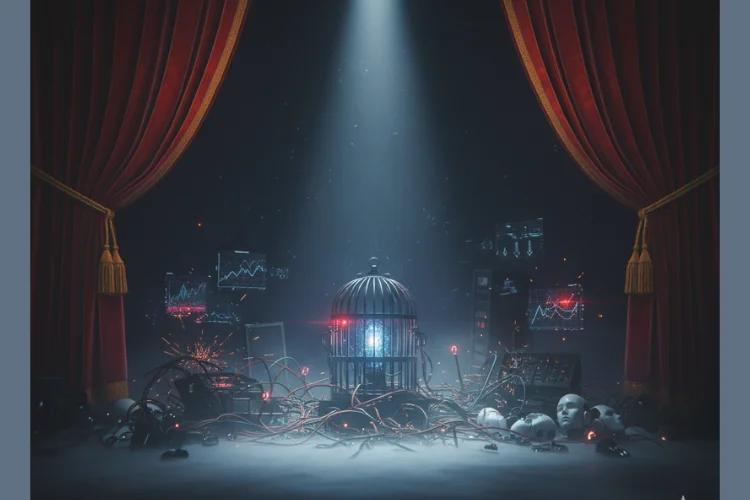1. Introduction: The $650 Ticket to the Future—or a Mirage?
OpenAI just hosted an event that felt more like a tech carnival than a developer conference. Tickets cost $650, and the announcements came in waves—apps inside ChatGPT, a new AgentKit toolkit, GPT-5 Pro, and Sora 2.
On the surface, it looked like a celebration of progress. But dig deeper, and the cracks start to show. OpenAI is claiming 800 million weekly users, yet its revenue only grew 16% this year. CEO Sam Altman even said profitability isn’t in his “top 10 concerns.”
So, what’s really going on? Is OpenAI building the future—or simply burning through billions while trying to justify a $500 billion valuation?
2. The $650 Developer Event: A Celebration or a Cash Grab?
The developer event was meant to inspire innovation, but it also raised eyebrows. Charging $650 to attend a company’s product showcase is a bold move—especially for a company that relies on developers to expand its ecosystem.
Many compared it to Apple’s WWDC or Google I/O, but there’s a key difference. Those events are platforms for developers to learn, grow, and build. OpenAI’s event, on the other hand, felt more like a ticketed PR push.
Yes, attendees got an early look at new features. But they also walked away with questions about OpenAI’s priorities. Was the event about empowering the developer community—or about monetizing its own hype?
3. Inside ChatGPT: Apps, Integrations, and the AgentKit Dream
The idea of apps inside ChatGPT sounds futuristic. Imagine a world where you don’t just chat—you build, run, and interact with mini-apps directly within the AI interface. That’s what OpenAI promises.
Then comes AgentKit, a toolkit that allows developers to build AI agents that interact with APIs, data, and workflows. On paper, it’s a dream come true for developers and Fractional CTOs who want scalable automation without heavy infrastructure costs.
But the execution raises questions. Will these “apps” live within OpenAI’s closed ecosystem, locking developers into yet another walled garden? Or will they truly empower innovation?
If OpenAI plays this right, AgentKit could become the foundation for a new kind of software development. If not, it could just be another overhyped feature that fades before it scales.
4. GPT-5 Pro: Innovation or Price Inflation?
OpenAI’s next big move is GPT-5 Pro, priced at $120 per million output tokens. That’s a steep jump from GPT-4 Turbo, and it’s sparked plenty of debate among developers.
While OpenAI promises better reasoning, higher accuracy, and improved data handling, the pricing tells another story. Is the company using “premium access” as a strategy to boost short-term revenue?
Competitors like Anthropic and Google DeepMind are offering comparable power at lower costs. For startups, agencies, and Fractional CTOs, cost efficiency matters. GPT-5 Pro might be powerful—but if it’s too expensive to use at scale, its market appeal could fade fast.
OpenAI needs to prove that GPT-5 Pro is more than just an expensive upgrade. Otherwise, it risks alienating the very developer base that helped it rise to prominence.
5. Sora 2: The Copyright Catastrophe
Then there’s Sora 2, OpenAI’s upgraded video generation model. Within hours of its release, it became a copyright nightmare.
Sora 2 can generate realistic videos from text prompts—but it’s already facing backlash from artists, filmmakers, and copyright holders. The legal boundaries of AI-generated content remain unclear, and Sora 2 is pushing those limits faster than the law can catch up.
While OpenAI claims it’s implementing “responsible safeguards,” experts disagree. Many fear that Sora 2 could lead to mass copyright violations, deepfake misuse, and reputational risks for creators who use it unknowingly.
This isn’t just an ethical issue—it’s a business one. If OpenAI continues to invite controversy, it could face stricter regulations and legal scrutiny that slow innovation and drain resources.
6. Sam Altman’s Surprising Statement: “Profitability Isn’t a Top 10 Concern”
During the event, Sam Altman made a statement that stunned analysts:
“Profitability isn’t even in my top 10 concerns.”
In an age of rising AI competition and investor pressure, this is either visionary courage—or financial recklessness.
Altman’s vision has always been about long-term transformation rather than short-term gains. But investors and enterprise partners want sustainability. When a company valued at half a trillion dollars says profit doesn’t matter, it sends a mixed message.
Yes, innovation requires patience. But even the most ambitious AI companies need financial discipline. OpenAI’s challenge isn’t just building great technology—it’s proving it can build a lasting business around it.
7. 800 Million Weekly Users… But Only 16% Revenue Growth
OpenAI proudly claims 800 million weekly users. That’s a staggering number—one that puts ChatGPT among the most used AI tools in the world.
But here’s the problem: its revenue only grew 16% this year. For a company of OpenAI’s scale, that’s alarmingly slow.
Some analysts believe the usage figures include free users, not paying customers. Others argue that OpenAI’s monetization strategy is too fragmented—spread across ChatGPT Plus subscriptions, enterprise plans, and API usage.
In short, OpenAI may have a massive audience, but it hasn’t figured out how to convert that popularity into stable, recurring revenue.
If the goal is to become the “Apple of AI,” OpenAI must balance accessibility with profitability. Otherwise, growth without monetization will lead to stagnation.
8. The $500 Billion Valuation: Ambition or Illusion?
OpenAI’s rumored $500 billion valuation sounds impressive—but is it justified?
Investors are betting on the future, not the present. They’re assuming OpenAI will dominate AI infrastructure, enterprise software, and agent ecosystems. But right now, those are aspirations, not achievements.
Companies like Google DeepMind, Anthropic, and xAI are closing the innovation gap quickly. OpenAI may have the brand power, but competitors are quietly building models that match or even outperform GPT in specialized tasks.
If OpenAI can’t sustain growth while maintaining leadership, its valuation could collapse under its own weight. The danger lies in overpromising a future that may take years—or even decades—to realize.
9. Behind the Curtain: Problems Hiding in the Hype
OpenAI’s biggest challenge isn’t competition—it’s expectation.
The company is expanding aggressively into apps, APIs, agents, and media generation. But every new direction adds complexity. Each product demands infrastructure, compliance, and maintenance.
There’s also the trust factor. As AI grows more powerful, transparency and ethics become vital. Users want to know where their data goes and how the models are trained. Regulators are already questioning OpenAI’s data usage and copyright practices.
The company needs to strengthen its governance, improve communication, and prove it can operate responsibly. Without that, hype will eventually erode credibility.
In business terms, this is where the Fractional CTO mindset becomes critical—balancing innovation with operational discipline, scalability, and financial prudence.

10. Conclusion: Building the Future—or Buying Time?
OpenAI is undoubtedly shaping the AI era. Its innovations are groundbreaking, and its ambitions are sky-high. But ambition without accountability is a risky path.
The company stands at a crossroads: one direction leads to sustainable innovation, while the other risks becoming a case study in overvaluation and overreach.
OpenAI’s leadership needs to move beyond announcements and prove its ability to execute, scale, and earn trust in the long run.
As StartupHakk often emphasizes, the future belongs not to those who make the loudest noise—but to those who build the most value.




